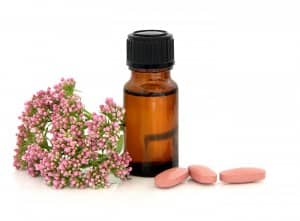Over-the-counter products such as antihistamines, valerian, and melatonin have risks and benefits, just like prescription hypnotics.
As sleep medicine practitioners, we are all aware of the importance of taking a history of prescription medicines, as well as educating the patient about the benefits and potential side effects of medicines we prescribe. In this article, we’ll review the reasons that it’s equally important to explore the history of over-the-counter (OTC) sleep aids—and to provide useful information about them.
Roughly half of adults with sleep difficulties are taking a prescription hypnotic, OTC sleep aid, or dietary supplement. About one in five is taking an OTC sleep aid.1 These compounds are often used for prolonged periods; a Consumer Reports survey found that 41% of people using them did so for over a year.2 This takes on special concern in view of data linking long-term use of antihistamines with an increased risk of the later development of dementia. Although there are less systematic data, clinical experience suggests that patients sometimes take both prescription and OTC sleep aids in combination. The concern here, of course, is the possibility of interactions, such as greatly increased sedation from a combination of antihistamines and benzodiazepines.
In the following sections, I’ll present the information that I’ve found most helpful in educating patients, in the language and degree of detail appropriate to an office setting. Of course this varies with educational level, cultural background, and other factors, but it may serve as a guide.
Antihistamines
Most OTC sleep aids are antihistamines, usually diphenhydramine or sometimes the related compound doxylamine. Diphenhydramine is sold both by itself and in combination with the pain medicine acetaminophen in what are known as “PM” products. It has been around since the 1940s, when it was developed for allergies; when it was noted that many people taking it during the daytime became drowsy, it began to be used as a nighttime sleep aid and has been marketed as such since the 1980s. Although diphenhydramine became very popular, perhaps because it didn’t require a prescription, more careful scientific studies have found little benefit for sleep when given at night. One study even found that at the 50 mg dose it can make a person more restless during sleep.3
Many people reason that although the benefits of over-the-counter sleep aids aren’t so clear, they might be worth trying, because if they don’t need prescriptions they must be pretty safe. In the case of diphenhydramine, that’s a mistake—it has very significant side effects. When taken in the daytime it causes significant sleepiness, although this may decrease after several days’ use. In a test of simulated driving, 50 mg of diphenhydramine caused worse impairment than a 0.1% blood alcohol concentration.4
The data about next-day sedation following nighttime use are not as well established. A recent study using a kind of brain scanning system known as positron emission tomography (PET) found that in the morning after taking diphenhydramine 50 mg, diphenhydramine molecules were still significantly attached to histamine receptors, suggesting the drug was still influencing the nervous system.5
Interestingly, in both the simulated driving study and the PET study, participants who took the active medicine did not describe themselves as sedated. Whether a person believes themself to be sedated is not a reliable measure of whether they are in fact being affected by the medicine.
In addition to influencing histamine, diphenhydramine also blocks the function of another transmitter in the brain known as acetylcholine. This can lead to a variety of “anticholinergic” side effects including dry mouth, blurred vision, difficulty urinating, and difficulties with memory.
Another concern about diphenhydramine is its use in older persons. It can cause confusional states, and indeed diphenhydramine appears on a well-established list (“the Beers criteria”) of drugs to be avoided in the elderly.6
It has also been associated with the risk of later developing dementia, particularly in long-term use. In one study, people taking antihistamines for 3 or more years had a 50% increased risk of dementia compared with those who took them for 3 months or less.7
In summary, the evidence that diphenhydramine is helpful for insomnia is slight, but its side effects are very clear.
Valerian
Valerian is probably the most widely used herbal product for sleep. It comes from water- or alcohol-based extracts from the roots of the flowering plant Valeriana officinalis. Sometimes it is combined with lemon balm or hops, which some claim have sedative properties.
As a plant extract, it contains many different compounds. One slows down the chemical breakdown of the neurotransmitter GABA in the brain, while another binds weakly to the same GABA receptor complex at which benzodiazepines (“Valium-like drugs”) act. Whether its potential sedating properties are related to these actions, or some other, is not certain.
Studies of valerian for sleep have had mixed results, ranging from an occasional positive study suggesting that it aids insomnia in post-menopausal women8 to a negative study using brainwave (EEG) measures in adults over 50.9 One study found that persons given a combination of valerian and hops reported a decrease in severity of insomnia after 14 days and improved quality of life and EEG-measured sleep onset time after 28 days.10 Some, but not all, studies have found an increase in slow-wave sleep (stage N3), although the clinical significance of this is not clear. A careful review of available data found a tendency for reports of improved sleep quality but noted that most studies had methodological problems or possible publication bias.11
Any possible benefits of valerian also need to be weighed against side effects, which can include intestinal disturbances, anxiety, headache, heart palpitations, dizziness, and sleep disturbance. As with all dietary supplements, purity is not as closely regulated as with prescription medicines. A 2013 study of 10 valerian preparations found a wide range of ingredients and quantity of extract, as well as reported lead contamination in two of them.12
Melatonin
Unlike valerian, which is extracted from plants, melatonin is a hormone found in the human body that is released into the bloodstream when it is nighttime and dark. It is released from the pineal gland, a small pine cone-shaped structure in the back of the brain. Some people call it the “hormone of darkness.” It is sold as a food additive, and in recent years 3 million Americans have used it for sleep.13 Its popularity appears to be growing, particularly for use in children.14
When looking at the scientific literature, it turns out that melatonin may have some usefulness in regulating sleep and waking in several specialized conditions. These include jet lag, as well as delayed sleep phase syndrome (in which the body’s timing for sleep runs later than typical sleep time), and non-24-hour sleep-wake disorder, in which the body clock operates with a different day length than our 24-hour world.
In contrast to these situations, there is little evidence that melatonin is effective in chronic insomnia. Several reviews of the available data have concluded that it has little or no overall benefits. One found that on average it increased total sleep by only about 8 minutes and reduced time to fall asleep by about 7 minutes.15 One study of a very large dose (75 mg) described reported improvements in total sleep time,16 but this is very much larger than physiologic doses (0.5-1.0 mg), and its safety in these amounts has not been determined. Melatonin secretion declines in the elderly, who may also have shifts in the body clock’s timing of sleep, and some limited data indicate benefits in this situation. Overall, though, the utility of melatonin in chronic insomnia not due to body clock malfunction is uncertain.
Melatonin’s most common side effect is daytime sleepiness (in perhaps 20%). Less common are headaches, dizziness, bad taste in mouth, disturbed sleep, abdominal discomfort, and rarely sleepwalking and nightmares. It can also alter the effectiveness of other drugs, including some for blood thinning, diabetes, and birth control. As with valerian, its purity varies. One study measured the amount of actual melatonin in different products and reported that it ranged from 83% less to 478% more than advertised.17 Some researchers have also expressed concern about the frequency of contaminants in commercially available melatonin products.18
Broader Issues for Non-prescription Products
Several generalizations emerge from reviewing these over-the-counter products.
- Just because something is natural or doesn’t require a prescription does not automatically mean it is safer.
- Over-the-counter substances are less well-regulated than prescription medications, and their purity and quantity may vary across different products.
- Diphenhydramine, valerian extracts, and melatonin have been reviewed and not been recommended for chronic insomnia by the American Academy of Sleep Medicine.19
In summary, over-the-counter substances should be treated like all medicines, in which one weighs the potential benefits against risks. In the case of these sleep aids, benefits are very limited and expose the user to a range of side effects. It seems wiser to guide the patient toward more well-established treatments for chronic insomnia.
Wallace B. Mendelson, MD, is a retired professor of psychiatry and clinical pharmacology at the University of Chicago, former director of the Sleep Research Laboratory at the University of Chicago, and past president of the Sleep Research Society. His most recent book, Understanding Sleeping Pills, draws on his 40 years of experience doing research and treating insomnia to explain how sleeping pills work on the central nervous system and their benefits and drawbacks, as well as alternative non-medicine approaches.
References
1. Albert SM, Roth T, Vitiello M, et al. Over-the-counter sleep aids. March/April 2016. Today’s Geriatric Medicine. 9(2):20.
2. Consumer Reports: Widespread Misuse of Common OTC Sleep Drugs May Pose Serious Health Risks. 2016 Dec 29. Available at www.consumerreports.org/media-room/press-releases/2016/12/consumer_reports_widespread_misue_of_common_otc_sleep_drugs_may_pose_serious_health_risks
3. Borbély AA, Youmbi-Balderer G. Effect of diphenhydramine on subjective sleep parameters and on motor activity during bedtime. Int J Clin Pharmacol Ther Toxicol. 1988 Aug;26(8):392-6.
4. Weiler JM, Bloomfield JR, Woodworth GG, et al. Effects of fexofenadine, diphenhydramine, and alcohol on driving performance. A randomized, placebo-controlled trial in the Iowa driving simulator. Ann Intern Med. 2000 Mar 7;132(5):354-63.
5. Zhang D, Tashiro M, Shibuya K, et al. Next-day residual sedative effect after nighttime administration of an over-the-counter antihistamine sleep aid, diphenhydramine, measured by positron emission tomography. J Clin Psychopharmacol. 2010 Dec;30(6):694-701.
6. 2019 American Geriatrics Society Beers Criteria Update Expert Panel. American Geriatrics Society 2019 Updated AGS Beers Criteria® for Potentially Inappropriate Medication Use in Older Adults. J Am Geriatr Soc. 2019 Jan 29. [Epub ahead of print]
7. Gray SL, Anderson ML, Dublin S, et al. Cumulative use of strong anticholinergics and incident dementia: a prospective cohort study. JAMA Intern Med. 2015 Mar;175(3):401-7.
8. Taavoni S, Ekbatani N, Kashaniyan M, Haghani H. Effect of valerian on sleep quality in postmenopausal women: a randomized placebo-controlled clinical trial. Menopause. 2011 Sep;18(9):951-5.
9. Diaper A, Hindmarch I. A double-blind, placebo-controlled investigation of the effects of two doses of a valerian preparation on the sleep, cognitive and psychomotor function of sleep-disturbed older adults. Phytother Res. 2004 Oct;18(10):831-6.
10. Morin CM, Koetter U, Bastien C, et al. Valerian-hops combination and diphenhydramine for treating insomnia: a randomized placebo-controlled clinical trial. Sleep. 2005 Nov;28(11):1465-71.
11. Bent S, Padula A, Moore D, et al. Valerian for sleep: a systematic review and meta-analysis. Am J Med. 2006 Dec;119(12):1005-12.
12. ConsumerLab.com. Valerian “Sleep” Supplements Vary Widely in Key Compounds and Two Fail Tests for Lead Contamination. 23 Oct 2013. Available at www.consumerlab.com/news/valerian_supplement_review_problem/10-23-2013.
13. Clarke TC, Black LI, Stussman BJ, et al. Trends in the use of complementary health approaches among adults: United States, 2002–2012. National Center for Health Statistics. 2015; National health statistics reports;79. Available at www.cdc.gov/nchs/data/nhsr/nhsr079.pdf
14. Black LI, Clarke TC, Barnes PM, et al. Use of complementary health approaches among children aged 4–17 years in the United States: National Health Interview Survey, 2007–2012. National Center for Health Statistics. 2015;78. Available at www.cdc.gov/nchs/data/nhsr/nhsr078.pdf
15. Ferracioli-Oda E, Qawasmi A, Bloch MH. Meta-analysis: melatonin for the treatment of primary sleep disorders. PLoS One. 2013 May 17;8(5):e63773.
16. JG MacFarlane, et al. In the Pineal Gland. GM Brown and SD Wainright, Ed’s. 1991. Pergamon, New York:301-6.
17. Erland LA, Saxena PK. Melatonin natural health products and supplements: presence of serotonin and significant variability of melatonin content. J Clin Sleep Med. 2017 Feb 15;13(2):275-81.
18. Williamson BL, Tomlinson AJ, Mishra PK, et al. Structural characterization of contaminants found in commercial preparations of melatonin: similarities to case-related compounds from L-tryptophan associated with eosinophilia-myalgia syndrome. Chem Res Toxicol. 1998;11:234–40.
19. Sateia MJ, Buysse DJ, Krystal AD, et al. Clinical practice guideline for the pharmacologic treatment of chronic insomnia in adults: an American Academy of Sleep Medicine clinical practice guideline. J Clin Sleep Med. 2017 Feb 15;13(2):307-49.







